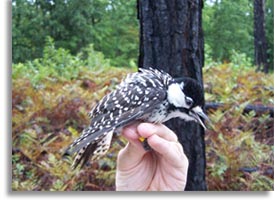|
November 30, 2007
 For
the first time ever, red-cockaded
woodpeckers (RCWs) have been moved onto private land in Alabama in an
effort to increase one of the state’s last remaining populations of this
endangered species. In the pre-dawn hours of November 9, 2007, a group of
biologists from the Alabama Department of Conservation and Natural
Resources (ADCNR), the U.S. Fish and Wildlife Service (USFWS), and the
Alabama Forest Resources Center (ALFRC) gathered at Enon Plantation near
Hurtsboro, Alabama. The stage was set for an historic event – the release
of seven juvenile red-cockaded woodpeckers that had been captured the
evening before at Fort Benning, Georgia. For
the first time ever, red-cockaded
woodpeckers (RCWs) have been moved onto private land in Alabama in an
effort to increase one of the state’s last remaining populations of this
endangered species. In the pre-dawn hours of November 9, 2007, a group of
biologists from the Alabama Department of Conservation and Natural
Resources (ADCNR), the U.S. Fish and Wildlife Service (USFWS), and the
Alabama Forest Resources Center (ALFRC) gathered at Enon Plantation near
Hurtsboro, Alabama. The stage was set for an historic event – the release
of seven juvenile red-cockaded woodpeckers that had been captured the
evening before at Fort Benning, Georgia.
Federally protected by the Endangered Species Act since 1973, the RCW has
suffered dramatic population declines as a combined result of fire
suppression and conversion of the once expansive, old-growth, southern pine
forests to agriculture, urbanization, and short-rotation pine plantations.
Prior to European settlement, RCWs were widespread and locally abundant in
the Southeast. By the late 1980s most remaining populations were small,
isolated, and declining. Today, Alabama is the largest RCW populations are
in national forests, but roughly a dozen breeding pairs are known to
persist on private land in just four counties – Bullock, Chilton, Coosa,
and Russell. These small populations will not survive without significant
habitat management because RCWs are sensitive to habitat degradation and
fragmentation.
Faced with the imminent loss of this species from his property, Enon
Plantation landowner Campbell “Cam” Lanier, III entered into a partnership
agreement with the Wildlife and Freshwater Fisheries Division of the ADCNR,
USFWS, and the ALFRC to translocate RCWs to his property.
Located in Bullock and Russell counties, Enon Plantation consists of over
11,000 acres and was originally used for farming and timber. Since the
1920s, quail hunting has been the primary activity on the plantation. Now
the prime forestland will also serve as safe harbor for RCWs, which prefer
open stands of longleaf and other southern pines. Planning for this
historic event began in 2006 with the decision by Lanier to put a plan in
motion to save the remnant population of RCWs on his land.
Endangered species recovery, while often centered on public lands, simply
cannot be achieved without the contributions of private landowners. “We are
fortunate in Alabama to have landowners who use conservation-based
management on their properties,” said Alabama Department of Conservation
and Natural Resources Commissioner M. Barnett Lawley. “The partnerships
formed by this program are significant in helping recover endangered
species such as the RCW.”
Literally overnight, Enon’s remnant population of RCWs was effectively
doubled with the release of the seven birds brought in from the large,
stable population at Fort Benning. “Everything went perfectly. We could not
have asked for better results. This early success is a tribute to the
dedication and commitment of all of the partners involved,” said Eric
Spadgenske, Private Lands Biologist with the U.S. Fish and Wildlife
Service. “The true measure of success, however, will be in how many of
these translocated RCWs enter the breeding population next spring.”
The technique of translocation in wildlife management is nothing new.
Noteworthy success stories in Alabama include the white-tailed deer and
eastern wild turkey. “The factors that make this translocation of RCWs
unique are that we are dealing with an endangered species and private lands
– something that has never been done before in Alabama,” said Mark Sasser,
Nongame Wildlife Program Coordinator for the Division of Wildlife and
Freshwater Fisheries.
The Alabama Department of Conservation and Natural Resources promotes wise
stewardship, management and enjoyment of Alabama’s natural resources
through five divisions: Marine Police, Marine Resources, State Lands, State
Parks, and Wildlife and Freshwater Fisheries.
|